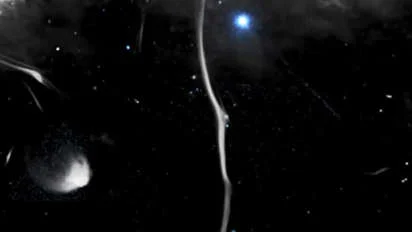
Cosmic Collision: Pulsar Slams into Milky Way’s “Snake” Filament, Reveals Galactic Fracture
A dramatic cosmic collision has been uncovered at the heart of our galaxy! Astronomers, utilizing data from NASA's Chandra X-ray Observatory and radio telescopes, have pinpointed the likely cause of a peculiar "fracture" in a massive structure within the Milky Way, dubbed the "Galactic Center Snake". This discovery sheds light on the powerful forces shaping our galaxy and reveals the surprising impact even stellar remnants can have on vast cosmic structures.
The "Snake," scientifically known as G359.13, is a 230-light-year-long filament, one of the largest and brightest of its kind observed near the Galactic Center. These filaments are essentially "bones" of the Milky Way, threaded with magnetic fields and energized particles, emitting radio waves. However, G359.13 has a noticeable break, a fracture that has puzzled astronomers.

The culprit? A fast-moving pulsar, a rapidly spinning neutron star, the incredibly dense remains of a massive star. According to a paper published in the Monthly Notices of the Royal Astronomical Society, the pulsar likely slammed into the Snake at speeds of 1 to 2 million miles per hour! This impact warped the Snake's magnetic field and disrupted its radio signal, causing the observed fracture.
"The major kink is created by a fast-moving object punching into the Snake, distorting its magnetic structure, and producing X-ray emission. X-ray emission pinpoints an active acceleration site where the interaction is taking place," the researchers explain. This energetic interaction also likely accelerated electrons and positrons, creating an extra source of X-ray emissions near the pulsar.

Farhad Yusuf-Zadeh of Northwestern University, a lead author of the study, highlighted the significance: the collision demonstrates how even the remnant of a dead star can dramatically affect its galactic environment. The discovery highlights that a single star can rattle the galaxy, even long after its own death.
The "Snake" analogy, while informal, helps illustrate the sheer scale and complexity of these galactic structures. These filaments are found near the Milky Way's center, energized by spiraling particles within the magnetic fields. While the origin and exact properties of these structures remain somewhat mysterious, the collision with the pulsar offers unique insights into their evolution.
The collision serves as a reminder of the dynamic and sometimes violent processes constantly occurring within galaxies. Further observations of the Galactic Center Snake will undoubtedly reveal more about the nature of these cosmic structures and the influence of energetic objects like pulsars on their evolution.
What other hidden dramas are unfolding at the center of our galaxy? Share your thoughts and theories in the comments below!